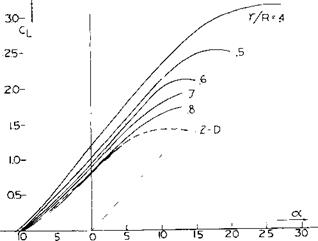FLUID DYNAMIC LIFT SECTION LIFT AS INFLUENCED BY ROTATION
Blade Section Lift: The thrust or lift produced by helicopter rotors, propellers and fans depends on the blade section lift characteristics. The lift of the blade sections is influenced by the three dimensional boundary layer developed on the blade due to the effects of rotation. Tests on various sections of a rotating propeller (24,a) have shown that both the lift curve slope and the maximum lift coefficient of a section will increase when installed on a rotating blade. These data (figure 38) show the increases are greater on the inboard sections. On the outboard sections of the propeller the section lift characteristics approach that of the two dimensional airfoil. These data confirm the pressure distribution data given in (24,b) and the operating characteristics of propellers which show much higher blade angles for stall than would be expected based on two dimensional airfoil data. This is illustrated by a Cu of 3.2 for the section near the hub, r/R = .4, compared with the two dimensional value of CL* of 1.4 as shown on figure 38.
The increase in Clx on the inboard sections is caused by a delay of separation due to the action of centrifugal force causing an outward displacement of the boundary layer and a corresponding reduction of its thickness. This boundary layer displacement sets up Coriolis forces (24,c) which accelerate the boundary layer in the direction of the flow. Thus a favorable gradient is set up which prevents separation and thus leads to the improved lift curve slope and the C^/ observed on the inboard sections of the propeller.
Based on the above it is apparent that when applying two dimensional airfoil data in the analysis of helicopter rotors, propellers and fans that the effects of rotation on the characteristics of the airfoil data must be considered. The effects of rotational speed, blade radius, airfoil type and basic operational lift will influence the magnitude of the change that can be expected.
|
Figure 38. Section lift coefficients as measured on a rotating propellei as a function of blade radius. |















